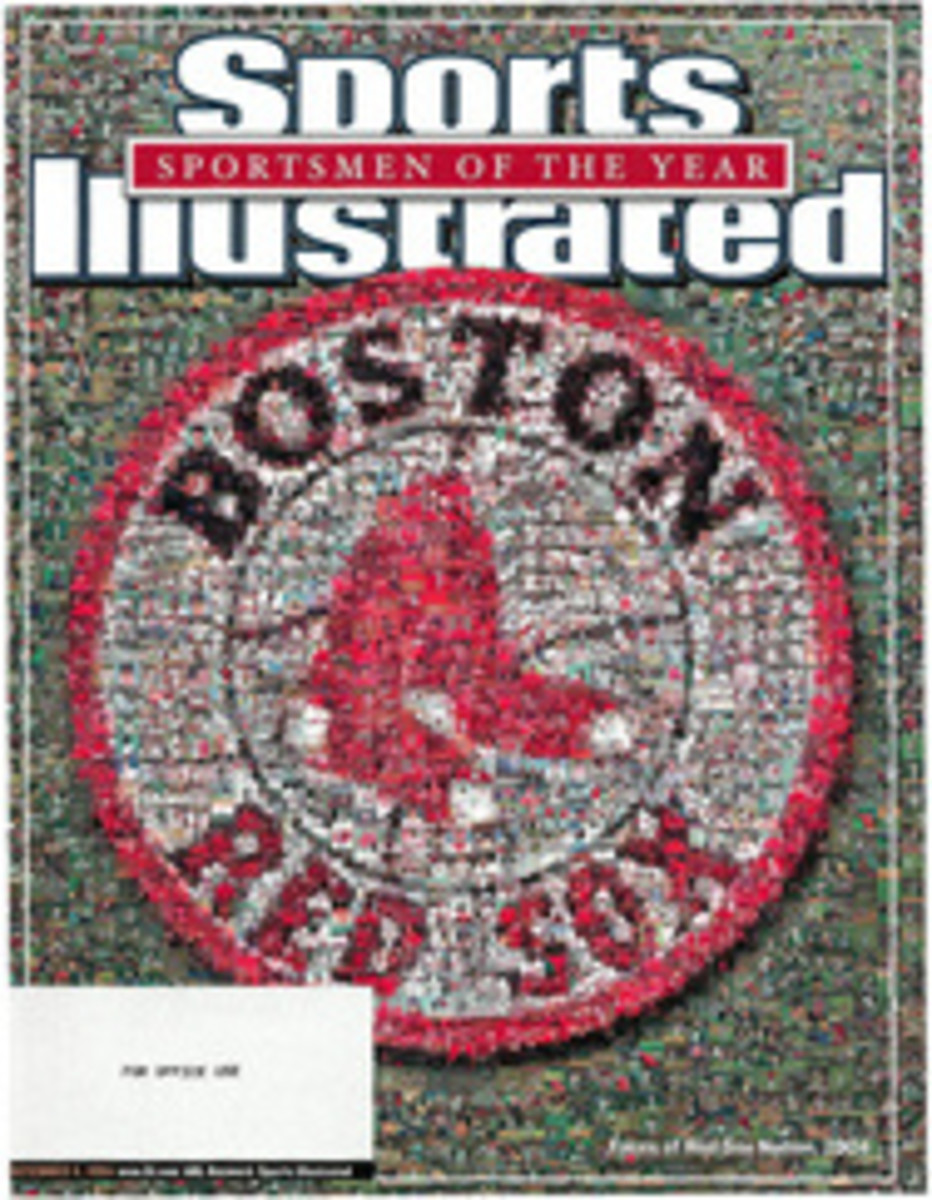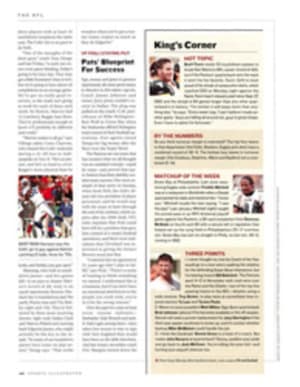
Business Is Taking Off
TYSON HALL first cottoned on to his younger brother Tanner's iconoclastic streak more than a decade ago, during a Christmas pageant at Northridge Lutheran Church in the boys' hometown of Kalispell, Mont. "This was epic," Tyson says. "They had the whole manger scene going, and seriously, Tanner was not more than four or five years old. He was one of the angels standing in the back singing, and our whole family was watching. My mom nudges me, and Tanner's got his sandals hanging from his ears, totally making a mockery of the whole thing, little sandals just chillin' around his ears." ¶ Tanner, now 21, retains a certain puerility. He speaks a Mountain West gangsta patois, drapes his 5'6", 140pound frame in baggy shirts and jeans, sometimes indulges in gold chains, and wears his white-blond hair loose and shaggy. To the question "If you could be any superstar, who would it be and why?" posed in an online questionnaire, he replied, "Willie Nelson--plays good music, evades his taxes and blazes cron." But in the universe of freeride skiing--a hybrid, trick-oriented descendant of skateboarding and snowboarding that is the fastest-growing discipline in skiing--Hall, despite his admiration of outlaw icons, is all business, a competitive and commercial force, his four consecutive X Games gold medals merely the most mainstream testament to his ability. Says Patrick Crawford, editor of the new-school bible Freeskier, "Tanner is, in terms of visibility, by far the big name."
Still, Hall's contrarianism endures. In 2002, frustrated with his chief sponsor, Rossignol, and what he felt was the company's overemphasis on traditional, racing-specific products, Hall joined with five fellow pros and all dropped their ski endorsement deals, partnered with a British venture capital firm and formed Armada Skis, a freeride-only manufacturer. Armada markets athlete-designed twin-tip skis--rounded at both ends, they are the freeride revolution's essential piece of equipment--and new-school gear, including hoodies, beanies and trucker caps. "For skiing to grow," Hall says, "we need more companies that embrace the sport, not race-oriented companies that happen to make twin-tips. We're not focused on racing at all, and we're coming up. We're taking over."
Armada is the slickest, most prominent exponent of a burgeoning trend: Six years after their sport's inception, freeriders now possess sufficient profile and capital that they can strike out on their own, slipping sponsors and industry stalwarts such as Rossignol, K2 and Salomon in favor of smaller, rider-owned outfits indifferent to the traditional racing mentality. These outfits not only permit but also encourage athletes to design their own models and push the technical envelope, and they reward them with an ownership stake in the enterprise. "Ultimately, the athletes conceived the idea," says 29year-old Hans Smith, who worked in the marketing department at Oakley, one of Hall's sponsors, before becoming Armada's CEO. "They wanted to create a company that originated with the rider and control how the skis were designed, how they were marketed, how they were skinned, the overall brand image. The best way to do that was to give them a venue and a lot of say."
Armada, like freeride in general, owes an intellectual debt to Jason Levinthal, 31, an Albany, N.Y., native who in 1995 fashioned one of the earliest incarnations of the twin-tip, as a senior project for his design degree at the University of Buffalo. Levinthal, who also skated, snowboarded and wakeboarded, preferred skiing, but that discipline lacked the equipment necessary for tricks that had become standard in other sports. "I remember making [it] and people asking, 'Why would you want to ride backward?'" Levinthal says. "My response was, 'Why not? I do on every other product I ride.'" Levinthal's skiboards, as he called them, represented a technical departure--their tails as well as their tips were rounded, so riders could ski, take off or land "switch" (meaning forward or backward), and they were wider than standard skis. On his skiboards Levinthal could move as if he were skating or snowboarding. After finding no interest in the concept from major manufacturers, Levinthal started Line Skis and began producing skiboards on spec.
"The path I was following was laid out by other action sports," Levinthal says. "Being a consumer of all those sports--wakeboarding, BMX, skating, snowboarding--transferring that to skiing seemed like a no-brainer to me." This was Levinthal's crucial, syncretic insight: Absent financial backing from established manufacturers and distributors, skiers, like the snowboarders who came before them, should begin by asking how they themselves want to innovate and what they want to ride, then conceive, design and market that equipment on their own. "No one was ready to start from scratch, and that's what I wanted to do," Levinthal says. "It takes a redesign of the product to support a whole new level of use, and then people get excited about the sport and want to participate."
Line burst into existence at a propitious time; skiing had surrendered the coveted teen-twentysomething male demographic to its action-sports counterparts, and the industry was content to emphasize racing even as its appeal sagged. But a group of Quebecois skiers, dubbed the New Canadian Air Force, that included J.P. Auclair and J.F. Cusson--now part owners of Armada--popularized freeride skiing. They prowled the backcountry, relishing the knotty conditions and launching jumps from natural obstacles; they migrated to man-made terrain parks, formerly the province solely of snowboarders, and they ground rails, jumped tabletops and skied half-pipes. Freeride instantly rejuvenated the industry, and Salomon leaped first, signing the New Canadian Air Force and putting out the Teneighty, which most consider to be the first mass-produced twin-tip.
Freeride grabbed Tanner Hall from the start. He had always bristled at constraints; his mother, Darla, recalls the fiasco of his first downhill race, at Big Mountain in Whitefish, Mont., when Tanner was about five years old. "All us mothers were down at the bottom watching," she says, "and Tanner came out, went through about four gates, came off the course into the trees, hit a jump and did a 360, then came back on course and finished the race." She laughs. "They kicked him off the team, but he always did like to be in the air." By the time he was 14 Tanner was an elite competitive moguls skier, and his parents enrolled him at The Winter Sports School in Park City, Utah, where he could train with an eye to making the Olympic team. Tanner disliked it almost from the start, had a series of run-ins with school officials and dropped out after two years.
"Moguls, the structure--it didn't work out," Tyson says. "Guys telling him spread-eagles and daffies were cool, but he couldn't do backflips; he wasn't buying into it." Tanner had to sell his parents on his dropping out to pursue freeriding competitions; his father, Gerry, was bitterly opposed, and the two didn't talk for six months. "I'd had U.S. Ski Association people tell me freeriding was a fad, that it wouldn't be there two years down the road, and I believed it," Gerry says. "It turned out they were afraid of the movement because it was draining them of quality athletes." After consulting with area high school counselors, Tanner, Gerry and Darla eventually compromised: Tanner would take one year to pursue competitive freeriding. If he failed, he'd go back to any school his parents chose.
Instead he blossomed instantly and won his first X Games title, in big air at Mount Snow, Vt., in 2001. Surprised and a little unprepared for her son's meteoric ascent, Darla flew in at the last minute to root him on in the final. "I remember standing at the bottom of the mountain, waiting for the last two skiers to come down," Darla says, "and Candide [Thovex, the defending gold medalist] fell, and Tanner had taken first, and he said to me, 'Mom, don't cry, 'cause your mascara will run and you'll be on national TV.' Of course I was running around crying, from pride and relief."
Hall's subsequent career only burnished his credentials, and forming Armada, which would cater to his design specifications and promote him as a marketing draw, was a logical step up. Armada's THall, Tanner's first pro model, exemplifies the advantage Hall gains by being an owner of the company. The ski is a 160- to 180centimeter twin-tip that's stiff under the boot, with softer flexing points at the tip and tail and rounded edges underneath the boot for skiing rails. It's a highly specialized park ski--a poster on the newschoolers.com message board scoffed, "I can't even ski on [it] to get to the park"--but it is custom-made and ideal for Hall, a ski it is unlikely he could have persuaded Rossignol to produce. "Never," he says, "and this is supercool, on rails especially. It's so soft. This is what I wanted to be skiing on." To some extent it's an image piece, a ski that isn't designed for mass consumption but one that will remind consumers of Armada's hard-core freeride bona fides. And skiing, freeride especially, remains image- and athlete-driven.
"We see the influence of athletes on consumers, the loyalty people have to athletes' names," says Matt Sterbenz, an accomplished pro freeskier who founded 4FRNT, a rider-owned manufacturer, two years ago. "Pro-model skateboards and snowboards sell off the racks before the name brands do. The power of athletes is growing, and I see freestyle to be an athlete-oriented aspect of skiing."
Rider-owned companies currently compete for an extremely small slice of the pie: Twin-tips account for some 40,000 of the 600,000 pairs of skis sold annually in North America, and more than half of those 40,000 are produced by industry giants, who, though late to the party, have overwhelmed the market with their production and distribution infrastructure.
Competition and market vagaries will winnow down the dozen or so small, indie freeride companies that have cropped up in the last two years, but the sport is exploding, and rider-owned companies will continue to define its technical and aesthetic boundaries. "It's a really honest message," Sterbenz says. "Kids realize that this is the future of freestyle skiing, to build around a company with athletes' pro models."
Hall, who characteristically does not hesitate to make the grand gesture, goes further. "This is just the first go-round," he says. "Twenty years from now you won't see any race skis. You'll see every ski out there with a twin-tip."
"For skiing to grow," Hall says, "we need companies that embrace the sport. We're not focused on racing at all, and WE'RE
TAKING OVER."
 
COLOR PHOTO
DAWN KISH
X-CELLENT ADVENTURE
Hall (inset, and getting crossed up--way up--at Whistler, B.C.) is a four-time X Games gold medal winner.
COLOR PHOTO
Photograph by Scott Markewitz
 [See caption above]
COLOR PHOTO
SCOTT MARKEWITZ
FACE TIME
Bored by racing and moguls, Hall, here jumping a cliff at Points North in Cordova, Alaska, was born for freeriding.

